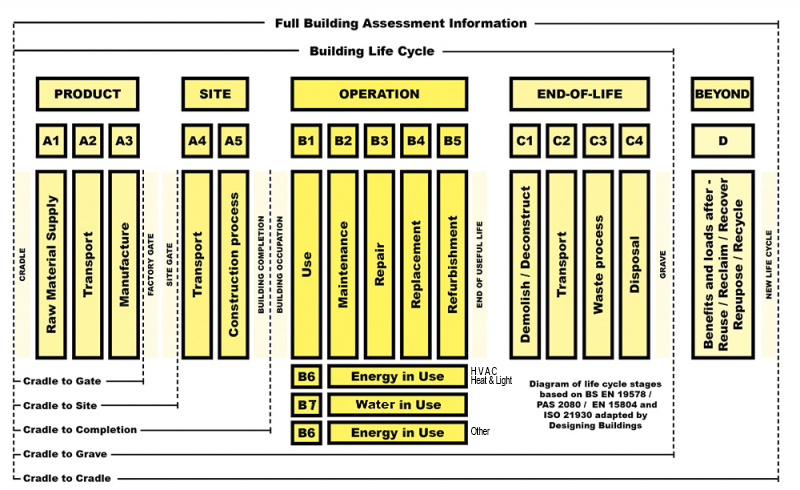Mandatory and optional environmental impact categories
EN 15804+A2 Sustainability of construction works - Environmental product declarations - Core rules for the product category of construction products - is the updated EN 15804 standard and refers to the full life cycle assessment including all stages of use.
[edit] Mandatory environmental impact categories
The updated EN 15804+A2 adjusts the list of mandatory environmental impact categories to include a greater level of definition:
- Climate Change - Total (CCT)
- Climate Change - Fossil (CCF)
- Climate Change - Biogenic (CCB)
- Climate Change - Land-use and Land Use Change (LULUC)
- Ozone Depletion Potential (ODP) - Ozone Depletion
- Photochemical ozone creation potential (POCP) - Photochemical ozone formation
- Acidification - (AP)
- Eutrophication aquatic freshwater - (EPAF)
- Eutrophication aquatic marine - (EPAM)
- Eutrophication terrestrial - (EPT)
- Abiotic depletion potential for minerals and metals (ADPMM)
- Abiotic depletion potential for fossil resources (ADPFR)
- Water use (WU)
[edit] Optional environmental impact categories
The updated EN 15804+A2 also has addition and optional environmental impact categories for EN 15804+A2, PEF; for stages A1-A3 and A4-A5, plus B1-7, C1-3 and D.
EN 15804+A2 disclaimer for Ionizing radiation, human health. This impact category deals mainly with the eventual impactof low dose ionizing radiation on human health of the nuclear fuel cycle. It does not consider effects due to possible nuclear accidents, occupational exposure or waste disposal. Potential ionizing radiation from the soil, from radon and from some construction materials is also not measured by this indicator.
- Particulate matter (Incidence)
- Ionizing radiation, human health (kBq U235e)
- Eco-toxicity (freshwater) CTUe
- Human toxicity, cancer effects (CTUh)
- Human toxicity, non-cancer effects (CTUh)
- Land use related impacts/soil quality
TRACI 2.1
- Global warming potential kg CO2e
- Ozone depletion kg CFC11e
- Photochemical smog formation kg O3e
- Acidification kg SO2e
- Eutrophication kg Ne
- Depletion of non-renewable energy MJ
Use of Natural Resources
- Renewable PER used as energy MJ
- Renewable PER used as materials MJ
- Total use of renewable PER MJ
- Non-renew. PER used as energy MJ
- Non-renew. PER used as materials MJ
- Total use of non-renewable PER MJ
- Use of secondary materials kg
- Use of renewable secondary fuels MJ
- Use of non-renew. secondary fuels MJ
- Use of net fresh water m3
PER abbreviation stands for primary energy resources
- Hazardous waste kg
- Non-hazardous waste kg
- Radioactive waste kg
End-of-Life Output flows
- Components for reuse kg
- Materials for recycling kg
- Materials for energy recovery kg
- Exported energy MJ
[edit] Related articles of Designing Buildings
- An in-depth look at Environmental Product Declarations EPDs.
- British Standards
- BS EN 15978-1
- Collaboration, standards and their acronyms explained.
- European Standards
- Environmental product declaration EPD
- EN 15804+A1 2012
- International Standards
- Mandatory environmental impact categories
- Optional environmental impact categories
- Product Environmental Footprint PEF
- Product category rules PCR.
- Sustainable procurement.
- The sustainability of construction works.
Featured articles and news
Skills England publishes Sector skills needs assessments
Priority areas relating to the built environment highlighted and described in brief.
BSRIA HVAC Market Watch - May 2025 Edition
Heat Pump Market Outlook: Policy, Performance & Refrigerant Trends for 2025–2028.
Committing to EDI in construction with CIOB
Built Environment professional bodies deepen commitment to EDI with two new signatories: CIAT and CICES.
Government Grenfell progress report at a glance
Line by line recomendation overview, with links to more details.
An engaging and lively review of his professional life.
Sustainable heating for listed buildings
A problem that needs to be approached intelligently.
50th Golden anniversary ECA Edmundson apprentice award
Deadline for entries has been extended to Friday 27 June, so don't miss out!
CIAT at the London Festival of Architecture
Designing for Everyone: Breaking Barriers in Inclusive Architecture.
Mixed reactions to apprenticeship and skills reform 2025
A 'welcome shift' for some and a 'backwards step' for others.
Licensing construction in the UK
As the latest report and proposal to licence builders reaches Parliament.
Building Safety Alliance golden thread guidance
Extensive excel checklist of information with guidance document freely accessible.
Fair Payment Code and other payment initiatives
For fair and late payments, need to work together to add value.
Pre-planning delivery programmes and delay penalties
Proposed for housebuilders in government reform: Speeding Up Build Out.
High street health: converting a building for healthcare uses
The benefits of health centres acting as new anchor sites in the high street.
The Remarkable Pinwill Sisters: from ‘lady woodcarvers’ to professionals. Book review.
Skills gap and investment returns on apprenticeships
ECA welcomes new reports from JTL Training and The Electrotechnical Skills Partnership.
Committee report criticises UK retrofit schemes
CIOB responds to UK’s Energy Security and Net Zero Committee report.

























